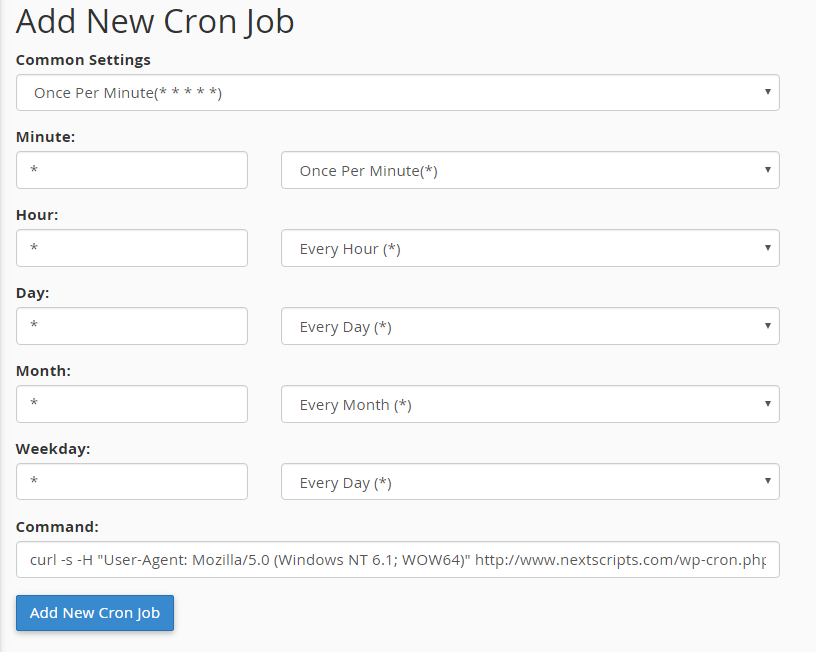Cron jobs are typically located in the spool directories. They are stored in tables called crontabs. You can find them in /var/spool/cron/crontabs. The tables contain the cron jobs for all users, except the root user. The root user can use the crontab for the whole system. To display contents of the root user’s crontab, use the less command. Setting up cron jobs in Unix and Solaris. Cron is a unix, solaris utility that allows tasks to be automatically run in the background at regular intervals by the cron daemon. These tasks are often termed as cron jobs in unix, solaris. Crontab (CRON TABle) is a file which contains the schedule of cron entries to be run and at specified times. Install crontab by script: Put file to /etc/cron.d. Remember to set env: 1.2 Cron job – common. Name Comment; Find crontab daemon process: pgrep crond.
System wide crontab
/etc/crontab
cron.d
Other crontabs can be put into /etc/cron.d/
Create a user specific crontab
As user:
Cron: A daemon that executes commands at specified times and dates, according to instructions in the crontab file. Crontab file: A file that specifies the dates and times at which e.g. User-specified commands are to be executed. Daemon: A computer program that runs as a background process not under direct influence of a user. CRON Examples: Note that all the cron jobs output are redirected to /tmp/log.txt. If omitted, the default is to send an email to the sysadmin email address (if configured). Run Python script every night at 02 am. 02. python /path/to/script.py /tmp/log.txt 2&1. Run PHP script once every two hours.
- crontab -e
The user specific crontabs are saved in /var/spool/cron/crontabs/
Deactivate cron

- service cron stop
Send output to specific email address
Azure Cron Cheat Sheet
Download adobe flash free mac. Per default cron sends output to the owner of the crontab file.
To redirect use the MAILTO variable. Put on top of the crontab:
Every 5 minutes
Use @reboot
Quiet cron (Output redirection)
Quiet cron, but send errors
Log output into logfile (stdout & stderr), but swallow stdout output
Crontab Cheat Sheet
-> All output is appended to logfile, but in case of errors a cron email ist sent Free architecture software for mac.
Run jobs with very low priority
Dont start a cronjob again before it's finished
sudo apt-get install run-one
Script aborted or crashed?
rm ~/.cache/run-one/*
Check which scripts are execute by e.g. cron.daily
run-parts --test /etc/cron.daily
- Created by Klemens Ullmann-Marx, 09/04/2009 20:53:10
- Updated by Klemens Ullmann-Marx, 06/24/2019 11:38:57
- Read access: Everyone, WikiAdmins, Logged in users | Write access: WikiAdmins, Logged in users
- Read counter: 2646 | Edit counter: 18
- Tags: cron, crontab, linux
Cron Syntax Cheatsheet
Healthchecks.io understands most of the traditional cron syntax features. Under the hood, it uses the croniter package to parse and interpret cron expressions. Below is a showcase of supported syntax features.
Pro-tip! On Unix-like operating systems, you can also easily access cron syntax documentation by typing man 5 crontab in shell.
A cron expression has five fields, separated by spaces. Asterisk is a wild card character and means 'any value.'
* | * | * | ||
|---|---|---|---|---|
| Day of week, 0 - 7, 0 or 7 is Sun | ||||
| Month, 1 - 12 | ||||
| Day of month, 1 - 31 | ||||
| Hour of day, 0 - 23 | ||||
| Minute, 0 - 59 | ||||
Use numeric values instead of asterisks to match specific minutes, hours, days, and months.
0 | * | 5 | ||
|---|---|---|---|---|
| Run only on Fridays | ||||
| Run every month of the year | ||||
| Run every day of the month | ||||
| Run at 6PM | ||||
| Run at the start of the hour | ||||
Use {v1},{v2},..,{vn} to list multiple values.
0 | * | * | ||
|---|---|---|---|---|
| Run on every weekday | ||||
| Run every month of the year | ||||
| Run every day of the month | ||||
| Run at 9AM, 12PM and 6PM | ||||
| Run at the start of the hour | ||||
Use {start}-{end} to define a range of matching values.
* | * | 1-5 | ||
|---|---|---|---|---|
| Run from Monday to Friday | ||||
| Run every month of the year | ||||
| Run every day of the month | ||||
| Run every hour of the day | ||||
| Run every minute of the hour | ||||
Use {start}-{end}/{step} or */{step} to define a range with a step.
*/15 | * | * | ||
|---|---|---|---|---|
| Run on every weekday | ||||
| Run every month of the year | ||||
| Run every day of the month | ||||
| Run every hour of the day | ||||
| Run every 15 minutes | ||||
In the comma-separated lists, you can combine not only numeric values but also ranges.
0 | * | * | ||
|---|---|---|---|---|
| Run on every weekday | ||||
| Run every month of the year | ||||
| Run every day of the month | ||||
| Run at 6PM, 7PM, 8PM, .., 7AM, 8AM | ||||
| Run at the start of the hour | ||||
JAN-DEC can be used in the month field and MON-SUN in the weekday field.
0 | 1 | * | ||
|---|---|---|---|---|
| Run on every weekday | ||||
| Run in April | ||||
| Run on the first day of the month | ||||
| Run every hour of the day | ||||
| Run at the start of the hour | ||||
The cron daemon uses the server's local time. If your server's timezone is other than UTC, make sure to set a matching timezone for your check on Healthchecks.io as well.
Crontab Cheat Sheet
On Ubuntu systems, you can check the server's timezone with:
